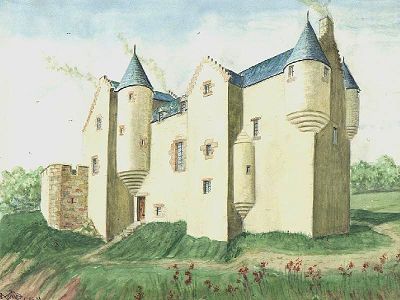 |
Artist: Andrew Spratt Custodian of Dirleton Castle. These images are the copyright of Mr. Spratt who has generously given permission to display them here. For more about Andrew Spratt click here. For a complete index of Mr. Spratt's castles on this site click here. Click on the castle to the left to view a larger image and scroll down to read more about the castle. Full size image of Auldhame Castle |
|
|
|||
When this ancient church was abandoned, likely due to the raids, allegedly made first by Vikings then by the English in the 13th century, the church was moved inland to the present safer location of Whitekirk village, which carried the name of the original white whinstone building, since the present kirk is bright red. The castle of Auldhame was erected by the Otterburn family, incorporating material from an earlier building, some time after 1550. Since they had such wild, flamboyant neighbours in the 'Red' Douglases of Tantallon castle, it is understandable why historians have neglected to cover the history of the Otterburns of Auldhame in any detail. The crow-stepped, gabled building had a yellow harling wash over its mixed rubble construction, which would have given it a bright yellow appearance against the steel grey waters of the North sea below. There was an outer barmkin-type wall which keyed into the east end of the castle and wrapped round towards the west side. Since the cliff has collapsed beside this wall and because of later quarrying, little remains to trace its bounds accurately. Likely, as with its grander neighbour Tantallon, a small village sprung up beside Auldhame but because these buildings were made of wood they quickly disappeared after the castle was abandoned in the 1700's.'Castle-town' before the walls of Tantallon, for example, was a substantial walled settlement with barns, stables and brewhouses. In 1651 Cromwell's army of 3,000 men spent two days fighting through the streets of 'Castle-town' before bombarding Tantallon itself. Today only the name Castleton farm survives as a reminder of what was once there. It is possible Auldhame was occupied and damaged by Cromwell's army during their 12 day bombardment of Tantallon. This was after Cromwell's defeat of the Scots army at Dunbar in 1650 and during his systematic destruction of Lothian castles held by Scots loyal to King Charles II (1660-1685). Auldhame is not mentioned in written reports to Cromwell as it was probably regarded as an unimportant house. Certainly Dirleton, Hailes, Innerwick and Tantallon are all noted in reports. Even Whitekirk church was used as a stable for General Monk's horses during the Tantallon siege. It could well be that the bodies beside Auldhame were Cromwell's dead from this siege, since it was impractical to carry their dead up and down the country. After the fall of Tantallon it was dismantled. Auldhame likely fell to a similar fate as Cromwell's men moved north. By the late 1700's Auldhame, like Tantallon, became the local quarry and was used to build cottages and walls nearby. Fortunately, something remains today of Auldhame to remind us of its past glory. Andrew Spratt Jan 1999
|